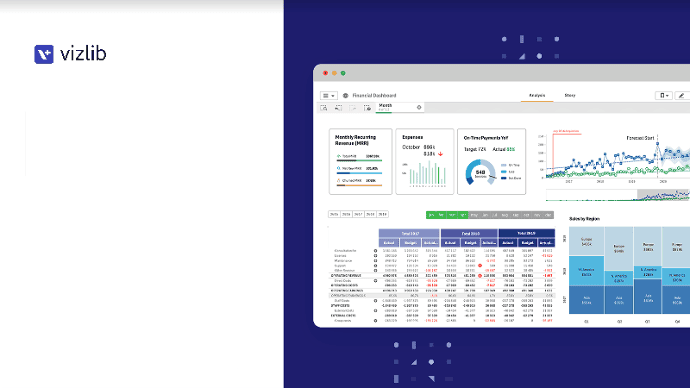The crucial role of a solid data strategy in companies
The crucial role of a solid data strategy in companies
Avoid flying blind:
In the digital age, data has become the lifeblood of businesses across all industries. Companies that harness the power of data gain a significant competitive advantage by making fact-based decisions, driving innovation, improving the customer experience and increasing overall performance. To achieve this, companies must develop and implement a solid data strategy. Below we explain the importance of a solid data strategy and its transformative impact on businesses.
Use data for solid decision making
A solid data strategy enables companies to make data-driven decisions rather than relying on gut feeling or intuition. By collecting, organizing and analyzing relevant data, companies can gain valuable insights into market trends, customer behavior and operational efficiency. This information enables leaders to make informed decisions that drive growth, mitigate risk and optimize resource allocation.
Increase operational efficiency
With effective data management, companies can streamline their operations and identify areas for improvement. With a solid data strategy, they can collect and analyze operational data to identify bottlenecks, optimize workflows, and increase productivity. By eliminating inefficiencies, they can also reduce costs, improve resource allocation, and increase operational efficiency.
Enable customized customer experiences
Personalization is key to building strong customer relationships and driving loyalty in today's customer-centric landscape. A robust data strategy enables companies to collect and analyze customer data to understand individual preferences, anticipate needs, and deliver tailored experiences. By leveraging customer insights, they can offer personalized recommendations, targeted marketing campaigns, and exceptional service, driving customer satisfaction and loyalty.
Promote innovation and agility
Data serves as a catalyst for innovation and enables companies to identify new trends and adapt to changing market conditions. A solid data strategy provides a company with a wealth of information, both internal and external, that can drive the development of new products, services and business models. With the help of data analytics, they can identify untapped opportunities, anticipate market changes and stay one step ahead of the competition.
Improve data security and compliance
At a time when there is increasing concern about data privacy and security, a solid data strategy is essential to protect sensitive information and ensure regulatory compliance. Implementing strong data governance practices, including data classification, access controls, and encryption, helps protect valuable corporate data. A well-defined strategy also helps companies comply with data protection regulations, such as the General Data Protection Regulation (GDPR) and other industry-specific requirements.
Fostering a data-driven company culture
Developing a solid data strategy involves more than just implementing technological solutions; it requires building a data-driven culture within the company. A data-driven culture emphasizes the importance of data integrity, accuracy, and accessibility across all departments. By fostering such a culture, companies can empower their employees to make data-driven decisions, use data insights effectively, and contribute to the overall success of the company.
In the age of big data, a solid data strategy has become a cornerstone of success for companies of all sizes and industries. From informed decision making to personalized customer experiences to driving innovation, data is a powerful asset that can unlock untapped potential and propel companies forward. By developing a solid data strategy, they can harness the transformative power of data to gain a competitive advantage and thrive in an increasingly data-centric business landscape.
From capture to AI-driven insights
From capture to AI-driven insights
We navigate the lifecycle of our customer data:
In the modern business landscape, data has become a valuable asset that informs decisions, drives innovation, and improves the customer experience. However, to realize the full potential of this data, a systematic approach across the entire lifecycle is required. From initial collection to advanced analytics, including integrating customer systems and leveraging AI, it is critical to understand and effectively manage each stage of the data lifecycle. Below we describe the key components of the data lifecycle and their importance in generating actionable insights for businesses.
Data Entry: Capturing the Foundation
The data lifecycle begins with data being entered into a company's systems. During this phase, data is collected from various sources such as customer interactions, transactions, sensors, or social media. It is important to ensure data quality and accuracy by implementing validation processes, error checking, and data governance measures. Data collection during this phase lays the foundation for all subsequent activities, which is why it is important to establish efficient and reliable data entry procedures.
Ensuring redundancy and resiliency
Data replication creates copies of the data collected to ensure redundancy and resiliency. Redundancy protects against data loss due to hardware failure, natural disasters, or system errors. Replicating data across multiple servers or data centers helps maintain data availability and facilitates recovery in the event of a disaster. Having redundant data allows companies to minimize downtime, ensure continuity, and protect valuable information.
Establish scalable and secure solutions
Efficient storage of data is critical for managing large amounts of information. Companies can choose between on-premises data storage and cloud-based solutions. On-premises storage offers direct control over the data, but requires significant investments in infrastructure and maintenance. Cloud-based storage, on the other hand, offers scalability, cost efficiency and simplified management. Regardless of the approach, security, compliance and data access control should be top priorities for data storage solutions.
Transform and Aggregate Data
Transforming and aggregating data involves converting raw data into a consistent format suitable for analysis. This phase includes data cleansing, normalization, integration, and enrichment. By harmonizing disparate data sources, companies can create a unified view of their data that enables more accurate and comprehensive analysis. Data aggregation helps identify trends, patterns, and relationships that are not apparent when examining individual data sets, providing a holistic perspective for informed decisions.
Single Point of Truth
A data warehouse acts as a central repository where structured data is stored and organized for analysis and reporting purposes. It consolidates data from different sources into a unified and optimized format, enabling efficient querying and reporting. Data warehouses form the foundation for data analysis and enable organizations to quickly uncover insights, make data-driven decisions, and derive value from their collected data assets.
Customer system integration
Customer system integration involves connecting customer data from different touchpoints such as CRM systems, support platforms and marketing automation tools. This integration enables a comprehensive view of the customer journey and enables companies to offer personalized experiences, targeted marketing campaigns and effective customer service. By connecting customer systems, companies can foster closer relationships, promote customer loyalty and gain a competitive advantage.
Streamline processes for better efficiency
Automation plays an important role in the data lifecycle as it reduces manual effort, increases accuracy, and improves efficiency. Automated processes include data entry, data transformation, data validation, and reporting. By implementing automation, companies can streamline data-related tasks, reduce human errors, and focus their human resources on more strategic activities. Automation speeds up data processing and enables companies to respond quickly to market changes and opportunities.
Data Analytics and Artificial Intelligence
The final phase of the data lifecycle involves analyzing data and using artificial intelligence (AI) techniques to gain meaningful insights. Data analytics, such as statistical analysis, data mining, and predictive modeling, uncover patterns, trends, and correlations in the data. By combining data analytics and AI algorithms, companies can gain deeper insight, create accurate forecasts, and make data-driven decisions. AI-driven analytics can uncover hidden potential, optimize processes, and improve overall business performance.
Effectively managing the data lifecycle is essential for organizations to realize the full potential of their data assets. From data collection and storage to data transformation, aggregation and analysis, each phase contributes to generating actionable insights. In addition, customer system integration, automation and the application of AI techniques increase the value of data and improve operational efficiency, customer experience and strategic decision making. By understanding and optimizing the data lifecycle, organizations can harness the power of data to drive innovation, gain a competitive advantage and succeed in the data-driven economy of today and the future.
In the cloud or on-premises:
Find the right decision for your company.
In the digital age, businesses face the critical decision of choosing the most suitable IT infrastructure to meet their operational needs. Traditionally, on-premise computing has been the norm, but the advent of cloud-based computing has revolutionized the way businesses manage their IT resources. Below, we will compare cloud-based computing with on-premise computing and highlight the key aspects that businesses need to weigh up in order to make an informed decision regarding their computing infrastructure.
Costs and scalability
Costs and scalability
On-premise computing requires significant upfront investments in hardware, software licenses, and infrastructure. Businesses must bear the costs of purchasing, maintaining, and upgrading equipment as their computing needs change. In contrast, cloud-based computing operates on a pay-as-you-go model that allows businesses to scale up or down resources as needed. This flexibility eliminates the need for large upfront investments and enables cost optimization by only paying for the resources consumed.
Data security and compliance
Data security and compliance
On-premises computing offers a higher level of control over data security because companies retain ownership of their infrastructure and can directly oversee it. However, maintaining robust security measures and complying with evolving regulations can be difficult and resource-intensive. Cloud service providers invest heavily in security protocols, encryption, and compliance certifications, often beyond the capabilities of individual companies. They employ dedicated teams of experts to protect data and ensure compliance, providing peace of mind for companies operating in highly regulated industries.
Reliability and disaster recovery
Reliability and disaster recovery
Cloud-based computing offers built-in redundancy and disaster recovery mechanisms. Service providers offer geographically distributed data centers, data replication, and automated backup solutions that ensure high availability and business continuity. While on-premise computing can achieve a similar level of reliability, it requires significant investment in redundant hardware, backup systems, and robust disaster recovery plans. Maintaining and testing these systems can be very resource-intensive, making cloud-based solutions an attractive option for organizations seeking a reliable and resilient computing environment.
Infrastructure maintenance and management
Infrastructure maintenance and management
With on-premise computing, companies are responsible for managing their hardware, software updates, security protocols and infrastructure maintenance. This requires a skilled IT team, regular monitoring and continuous investment in upgrades. With cloud-based computing, the responsibility of managing the infrastructure is transferred to the cloud service provider, allowing companies to focus on their core business. The providers take care of software updates, security measures and infrastructure scalability, freeing up valuable resources for strategic initiatives.
Agility and innovation
Agility and innovation
Cloud-based computing offers unparalleled flexibility and high return on investment. Companies can quickly provision resources, deploy applications and scale infrastructure to adapt to changing business needs. This flexibility enables companies to embrace new opportunities, experiment with innovative solutions and respond quickly to market demands. While on-premise computing is adaptable, it often requires additional time and resources for infrastructure changes, which can lead to delays in innovation and competitiveness.
Adaptation and control
Adaptation and control
On-premises computing allows for greater customization and control over the infrastructure and software stack. Organizations can tailor their systems to specific requirements, integrate with existing legacy applications, and maintain complete control over data access and management. Cloud-based computing does offer some customization, but it is within the scope of the service provider's infrastructure and software offering. Before considering a cloud solution, organizations should assess their customization needs and determine the level of control they require.
Conclusion
Choosing between cloud-based computing and on-premise computing is an important decision for organizations seeking optimal IT infrastructure. Both options have their advantages and disadvantages, and the choice depends on factors such as cost, scalability, security, agility, and control. Cloud-based computing offers flexibility, scalability, and lower maintenance, while on-premise computing offers the ability to customize and control. To make an informed decision that meets their individual needs, organizations should carefully consider their specific requirements, budget constraints, and long-term business goals. In many cases, a hybrid approach that combines the best of both worlds can be the ideal solution, leveraging cloud-based computing for certain tasks while keeping critical systems on-premises.
How can We Sugarcode your day?
How can We Sugarcode your day?

Licences
Licences
We supply the required software licences and advise on the best and most cost-effective solution, depending on our customers' needs.

Consulting
Consulting
Our experienced consultants and project managers will be happy to assist you in implementing the required solutions.

Development
Development
Each requirement is specific and is implemented quickly, accurately and precisely by our experienced developers using SCRUM methodology.

Support
Support
If you have any problems or questions, our support team will help you quickly and easily. By phone, email or in a personal online call.

Training
Training
You will learn how to use the individual tools at the RSG Academy. Simply explained, with German and English documentation as well as a practical approach.

Scaling
Scaling
Planning and expanding the deployed environment becomes simple and straightforward with our help.
Qlik Analytics
Qlik Analytics

QlikView
QlikView
The classic for in-memory data analysis and still unrivalled today. Fast, simple and flexible.

Qlik Sense
Qlik Sense
The next generation in data analysis, based on HTML and supported by an AI. Simple and super fast.

NPrinting
NPrinting
Distribute reports automatically, as Word, Excel, PowerPoint, HTML or as PixelPerfect Report. To internal or external recipients.

Qlik Connectors
Qlik Connectors
Ready-made connectors for SAP, MS SQL, Oracle, Apache Hive, YouTube, SharePoint and many more.

Qlik SaaS
Qlik SaaS
Use Qlik Sense and QlikView in the Qlik SaaS Cloud - exclusive or hybrid.

Vizlib Extensions
Vizlib Extensions
Extend the possibilities in Qlik Sense with the extensive Vizlib Extensions.
Qlik Data Integration
Qlik Data Integration

Replicate
Replicate
Real-time Data Streaming (CDC).
Extend enterprise data into live streams to enable advanced analytics and microservices with a simple, universal real-time solution.

Compose
Compose
Agile Data Warehouse Automation.
Quickly design, build, deploy and manage fit-for-purpose cloud data warehouses without manual coding.

Catalog
Catalog
Qlik Catalog is a modern enterprise data management solution that simplifies the process of cataloguing, managing, preparing and delivering data to users.
Advanced Qlik
Advanced Qlik

AutoML
AutoML
Bring the power of machine learning to your analyst teams with a simple, code-free user experience. Effortlessly create ML experiments, identify the most important factors in your data and train your models. Make predictions about the future.

App Automation
App Automation
With Qlik Application Automation, you can create dynamic processes that automatically respond to events and trigger informed actions in your favourite SaaS applications. For example, if a supplier drops in quality, appropriate actions are automatically launched.
Our Qlik Expertise
Our Qlik Expertise

Integration
Integration
We integrate your existing systems into an intelligent environment, with central process logic as well as digital communication.

Automation
Automation
With automation, you can automate your digital processes and thus save time and money.

Digitalization
Digitalization
We integrate your existing systems into an intelligent environment with central process logic and digital communication.

AI
AI
With automation, you can automate your digital processes and thus save time and money.

Trainings
Trainings
Trainings for your success. We are an official partner of QlikTech when it comes to consulting, licences or training.

Support
Support
Competent and direct. Our support helps you promptly when you need help. Online or directly in a remote call.

